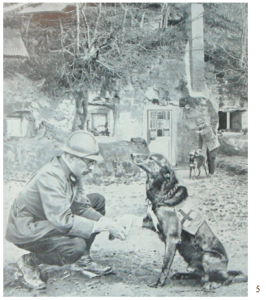Tuesday, June 22, 1915
Reserve Billets, Le Quesnoy
The Battalion War Diarist wrote for this day: “On the night of June 22nd, 1915, the 14th Battalion moved forward to reserve trenches (Givenchy Sector) and there passed two quiet and uneventful days.” [1]
 THIS DAY IN RMR HISTORY: “(Special Leased Wire) Paris, June 21 – A remarkable story of the new use to which police dogs (now called War Dogs) are put by the French came from Vosges. An experimental squad of twenty dogs, the account says, is stationed near the front line of trenches, whence they are sent singly at night to range over the ground between the French and German lines in search of wounded French men, whom they have been trained to distinguish. Each dog carries a small bottle of brandy tied to his body and also a light string tied to his collar. When a wounded man is found, the man pulls the string to which a coil of rope is fastened, ties the rope around his body and is then pulled back to the French trenches. The dogs work quite silently and so far none have been noticed by the enemy. They never assist Germans.”
THIS DAY IN RMR HISTORY: “(Special Leased Wire) Paris, June 21 – A remarkable story of the new use to which police dogs (now called War Dogs) are put by the French came from Vosges. An experimental squad of twenty dogs, the account says, is stationed near the front line of trenches, whence they are sent singly at night to range over the ground between the French and German lines in search of wounded French men, whom they have been trained to distinguish. Each dog carries a small bottle of brandy tied to his body and also a light string tied to his collar. When a wounded man is found, the man pulls the string to which a coil of rope is fastened, ties the rope around his body and is then pulled back to the French trenches. The dogs work quite silently and so far none have been noticed by the enemy. They never assist Germans.”
“The French war dogs are divided into five classes, each of which performs a special type of work. There are sentinel dogs, patrol dogs, ambulance dogs, dispatch bearers and draught dogs. In all these departments of military activity they have proved their worth. The development of this branch of military preparedness is a recent one, for the first of the French ‘chiens sanitaires’ was trained in 1907 and took part in the grand manoeuvres of that year. At the outbreak of the present war there were not more than one hundred of these useful dogs thoroughly trained. At present there are thousands of them serving with the French troops in the field.” [7]
[1] War Diary, 14th Canadian Battalion, The Royal Montreal Regiment, June 22, 1915. Library and Archives Canada, Ottawa http://data2.collectionscanada.ca/e/e044/e001089753.jpg
[2] R.C. Featherstonhaugh, The Royal Montreal Regiment 14th Battalion C.E.F. 1914-1925, Montreal, The Gazette Printing Co., Ltd., 1927, pg. 62.
[3] “Remarkable Work of French War Dogs,” Quebec Telegraph, Quebec, Monday, June 21, 1915, pg. 8, col. 4.
[4] Ibid
[5] The Illustrated London News, Saturday, December 25, 1915, No. 400E, pg. 1.
[6] https://sniffingthepast.wordpress.com/2012/02/08/warhorses-and-dogs-of-war/
[7] “Dogs of Battle and Dogs of Mercy,” Vanity Fair, September 1916, pg. 75. http://www.oldmagazinearticles.com/WW1_dogs_pdf



